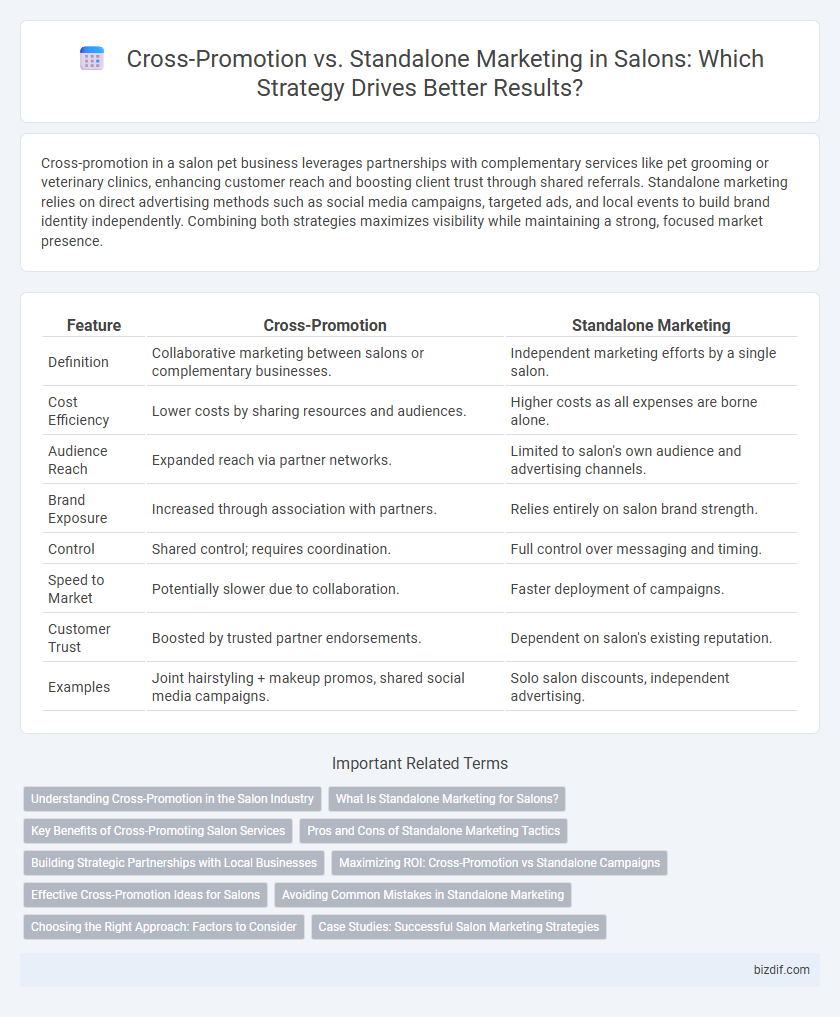Cross-promotion in a salon pet business leverages partnerships with complementary services like pet grooming or veterinary clinics, enhancing customer reach and boosting client trust through shared referrals. Standalone marketing relies on direct advertising methods such as social media campaigns, targeted ads, and local events to build brand identity independently. Combining both strategies maximizes visibility while maintaining a strong, focused market presence.
Table of Comparison
| Feature | Cross-Promotion | Standalone Marketing |
|---|---|---|
| Definition | Collaborative marketing between salons or complementary businesses. | Independent marketing efforts by a single salon. |
| Cost Efficiency | Lower costs by sharing resources and audiences. | Higher costs as all expenses are borne alone. |
| Audience Reach | Expanded reach via partner networks. | Limited to salon's own audience and advertising channels. |
| Brand Exposure | Increased through association with partners. | Relies entirely on salon brand strength. |
| Control | Shared control; requires coordination. | Full control over messaging and timing. |
| Speed to Market | Potentially slower due to collaboration. | Faster deployment of campaigns. |
| Customer Trust | Boosted by trusted partner endorsements. | Dependent on salon's existing reputation. |
| Examples | Joint hairstyling + makeup promos, shared social media campaigns. | Solo salon discounts, independent advertising. |
Understanding Cross-Promotion in the Salon Industry
Cross-promotion in the salon industry leverages partnerships with complementary businesses such as beauty supply stores or wellness centers to expand client reach and enhance service offerings. This strategy increases brand visibility and drives customer engagement by combining resources and marketing efforts, leading to higher client retention and increased revenue. Standalone marketing, while focused solely on the salon's own brand, often misses the broader audience opportunities created through strategic alliances and shared promotions.
What Is Standalone Marketing for Salons?
Standalone marketing for salons focuses on promoting the salon's unique services and brand identity independently, without relying on partnerships or external collaborations. It involves targeted campaigns such as personalized offers, loyalty programs, and direct advertising to attract and retain clients effectively. This approach strengthens brand recognition and builds a loyal customer base by highlighting exclusive salon experiences.
Key Benefits of Cross-Promoting Salon Services
Cross-promotion in salons leverages multiple services, increasing client engagement by encouraging customers to try complementary treatments like haircuts and manicures together. This strategy boosts average transaction value and customer retention by offering bundled discounts or loyalty rewards that standalone marketing often overlooks. Integrating cross-promotions enhances brand visibility and drives repeat visits, ultimately maximizing revenue and client satisfaction.
Pros and Cons of Standalone Marketing Tactics
Standalone marketing tactics in salon promotion allow for targeted messaging that directly highlights specific services, creating clear brand identity and stronger customer recall. These tactics provide complete control over campaign elements, resulting in precise budget allocation and measurement of marketing ROI. However, standalone campaigns may have limited reach and miss opportunities to leverage complementary businesses, potentially leading to higher customer acquisition costs compared to cross-promotion strategies.
Building Strategic Partnerships with Local Businesses
Cross-promotion in salons leverages strategic partnerships with local businesses such as gyms, cafes, and boutiques to mutually expand customer reach and enhance brand visibility. Standalone marketing, while focused solely on salon-driven campaigns, often limits exposure compared to collaborative efforts that tap into established clienteles. Building alliances with complementary local enterprises fosters community engagement and drives higher client acquisition through shared promotions and event collaborations.
Maximizing ROI: Cross-Promotion vs Standalone Campaigns
Cross-promotion leverages multiple salon services or local businesses to reach broader audiences, increasing customer engagement and boosting ROI more effectively than standalone marketing efforts. Standalone campaigns focus on a single service, which may limit audience reach and result in higher customer acquisition costs. Salons that integrate cross-promotional strategies see improved client retention and enhanced overall profitability through diversified marketing touchpoints.
Effective Cross-Promotion Ideas for Salons
Offering package deals that combine haircuts, manicures, and skincare services encourages clients to explore multiple treatments, boosting overall salon revenue. Partnering with local fitness centers or beauty product brands for joint promotions expands customer reach and enhances brand visibility. Utilizing social media collaborations with influencers who highlight various salon services generates authentic engagement and attracts new clientele effectively.
Avoiding Common Mistakes in Standalone Marketing
Standalone marketing in salons often underperforms due to lack of integrated brand messaging and limited customer reach, resulting in lower client engagement. Common mistakes include ignoring data analytics, failing to tailor promotions to target demographics, and underutilizing social media platforms, which reduces campaign effectiveness. Prioritizing personalized content and consistent follow-ups enhances customer retention and maximizes standalone marketing ROI.
Choosing the Right Approach: Factors to Consider
Choosing the right marketing approach for salons depends on target audience demographics, budget constraints, and brand positioning. Cross-promotion leverages partnerships with complementary businesses to expand reach efficiently, while standalone marketing offers full control over messaging and brand identity. Analyzing customer behavior, campaign goals, and resource availability helps determine whether integrated efforts or independent strategies yield higher ROI.
Case Studies: Successful Salon Marketing Strategies
Case studies reveal that salons leveraging cross-promotion with complementary local businesses experience a 30% increase in client retention compared to standalone marketing efforts. Integrating services such as spas or fitness centers in joint campaigns amplifies brand visibility and attracts diverse clientele. Standalone marketing often yields limited reach, while cross-promotional strategies maximize resource sharing and customer engagement effectively.
Cross-promotion vs Standalone marketing Infographic

 bizdif.com
bizdif.com